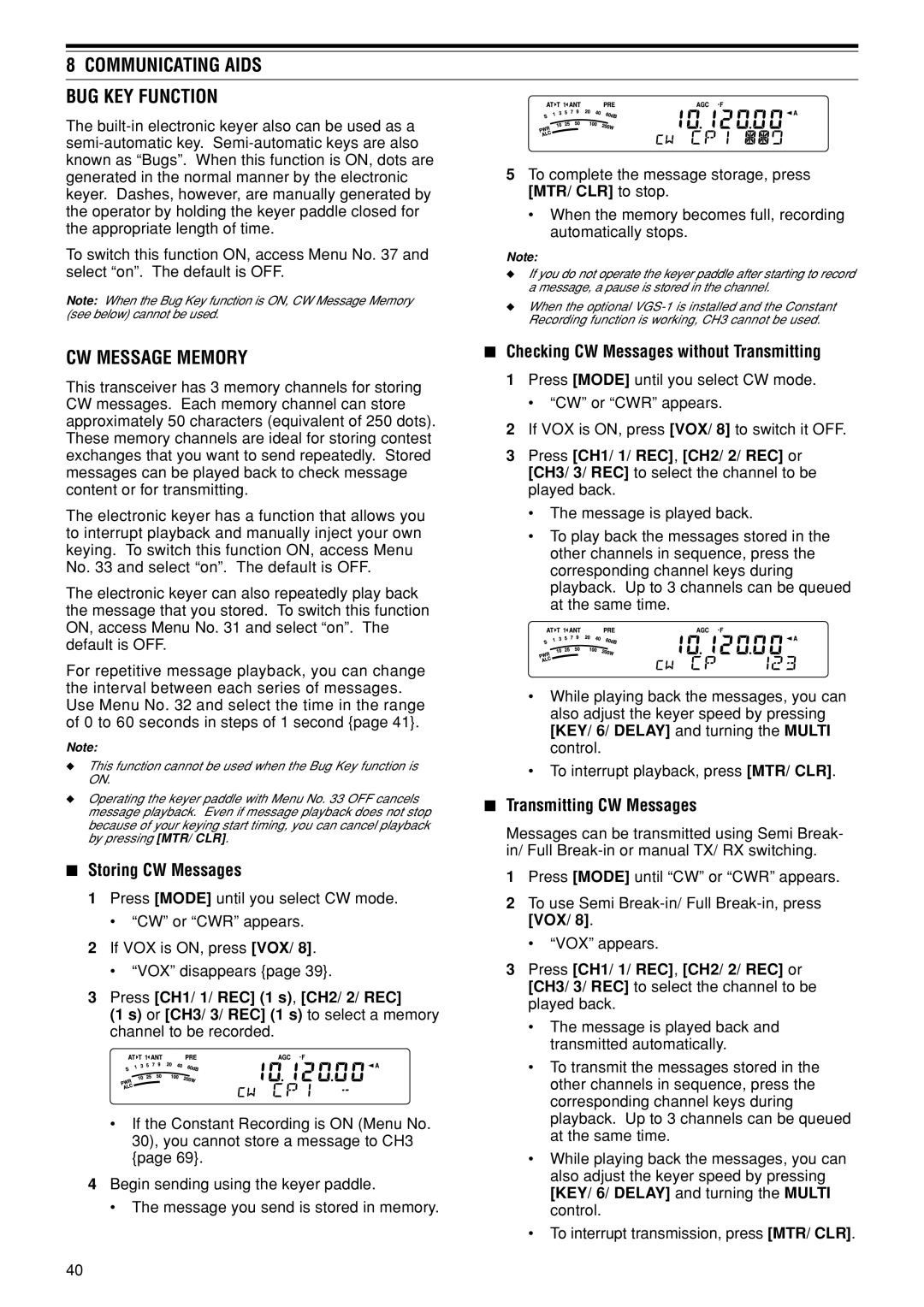
8COMMUNICATING AIDS BUG KEY FUNCTION
The
To switch this function ON, access Menu No. 37 and select ÒonÓ. The default is OFF.
Note: When the Bug Key function is ON, CW Message Memory (see below) cannot be used.
5To complete the message storage, press [MTR/ CLR] to stop.
¥When the memory becomes full, recording automatically stops.
Note:
◆If you do not operate the keyer paddle after starting to record a message, a pause is stored in the channel.
◆When the optional
CW MESSAGE MEMORY
This transceiver has 3 memory channels for storing CW messages. Each memory channel can store approximately 50 characters (equivalent of 250 dots). These memory channels are ideal for storing contest exchanges that you want to send repeatedly. Stored messages can be played back to check message content or for transmitting.
The electronic keyer has a function that allows you to interrupt playback and manually inject your own keying. To switch this function ON, access Menu No. 33 and select ÒonÓ. The default is OFF.
The electronic keyer can also repeatedly play back the message that you stored. To switch this function ON, access Menu No. 31 and select ÒonÓ. The default is OFF.
For repetitive message playback, you can change the interval between each series of messages. Use Menu No. 32 and select the time in the range of 0 to 60 seconds in steps of 1 second {page 41}.
Note:
◆This function cannot be used when the Bug Key function is ON.
◆Operating the keyer paddle with Menu No. 33 OFF cancels message playback. Even if message playback does not stop because of your keying start timing, you can cancel playback by pressing [MTR/ CLR].
■Storing CW Messages
1Press [MODE] until you select CW mode.
¥ÒCWÓ or ÒCWRÓ appears.
2If VOX is ON, press [VOX/ 8].
¥ÒVOXÓ disappears {page 39}.
3Press [CH1/ 1/ REC] (1 s), [CH2/ 2/ REC]
(1 s) or [CH3/ 3/ REC] (1 s) to select a memory channel to be recorded.
¥If the Constant Recording is ON (Menu No. 30), you cannot store a message to CH3 {page 69}.
4Begin sending using the keyer paddle.
¥The message you send is stored in memory.
■Checking CW Messages without Transmitting
1Press [MODE] until you select CW mode.
¥ÒCWÓ or ÒCWRÓ appears.
2If VOX is ON, press [VOX/ 8] to switch it OFF.
3Press [CH1/ 1/ REC], [CH2/ 2/ REC] or [CH3/ 3/ REC] to select the channel to be played back.
¥The message is played back.
¥To play back the messages stored in the other channels in sequence, press the corresponding channel keys during playback. Up to 3 channels can be queued at the same time.
¥While playing back the messages, you can also adjust the keyer speed by pressing [KEY/ 6/ DELAY] and turning the MULTI control.
¥To interrupt playback, press [MTR/ CLR].
■Transmitting CW Messages
Messages can be transmitted using Semi Break- in/ Full
1Press [MODE] until ÒCWÓ or ÒCWRÓ appears.
2To use Semi
¥ÒVOXÓ appears.
3Press [CH1/ 1/ REC], [CH2/ 2/ REC] or [CH3/ 3/ REC] to select the channel to be played back.
¥The message is played back and transmitted automatically.
¥To transmit the messages stored in the other channels in sequence, press the corresponding channel keys during playback. Up to 3 channels can be queued at the same time.
¥While playing back the messages, you can also adjust the keyer speed by pressing [KEY/ 6/ DELAY] and turning the MULTI control.
¥To interrupt transmission, press [MTR/ CLR].
40
